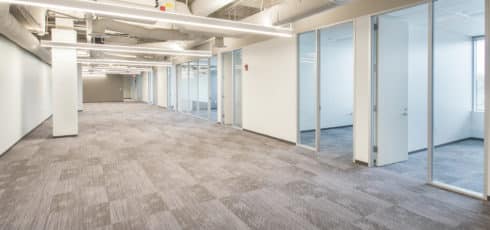Austin is known as one of the most dog-friendly cities in the U.S and many people have one or more furry friends.
But, what happens when you have to be at the office all day with a long commute to and from work? Many urban areas lack yards to leave pups in and many are kept indoors. This can mean people have to hire daily dog walkers or leave work to care for their pets.
Read Next: The Ultimate Guide to Commercial Real Estate Marketing
Could allowing dogs in your office building solve these problems and help you attract tenants who have these issues?
In this article, we outline the pros and cons of dog-friendly office buildings to help you decide if it could be right for your property.
Pros
Recruiting Tool For Tenants
In a city like Austin, where unemployment rates are some of the lowest in the nation and companies are competing with tech giants like Google, Amazon, and Facebook for top talent, offering perks like dog-friendly offices can be a way for smaller companies to attract and retain talent. This perk can also help your tenant retain employees. Having a dog-friendly workplace is now a highly sought-after perk for job hunters due to the mental health benefits and money-saving aspects.
One of the best advantages of allowing dogs in your building is the mental health benefits for tenants and their employees. Having pets in the office has been shown to reduce stress and improve mental health. According to Rover.com, 25% of pet owners said when they bring their dog to work, the number one reason they enjoy it is because of the emotional support they provide. Also, According to NPR, employees who bring their dogs to work experience lower stress levels than those who don’t bring their dogs to work.
Having a dog at work also forces employees to take their dogs outdoors and occasionally walk them around the office. These small tasks let employees take a break from their work and rest their brains. Breaks have been shown to increase productivity throughout the workday.
Allowing tenants to have dogs in their office space can help their employees save money on dog care without incurring much cost to the tenant or the landlord. Many employees endure long commutes that prevent them from being able to go home to let their dog out – leading them to have to hire someone to care for their dog.
The ability for a company to offer this type of benefit to employees can be a major differentiator and may influence where a company chooses to office.
Rare Amenity
Despite the potential benefit to tenants outlined above, very few landlords allow dogs in their buildings. This can make it hard for tenants who offer the perk of allowing their employees to bring their dogs to work to find office space. By choosing to allow dogs in your building, you can attract these tenants who are looking for this type of space.
It can be incredibly difficult for tenants to locate space that allows dogs. Currently, if you google “dog-friendly office space Austin” there is no dog-friendly office space for lease on the first page of google except coworking space. If you advertise your office space as dog-friendly, you can capture the interest of this niche market.
Tenants May Be More Likely To Renew Their Lease
Once a company has established a dog-friendly atmosphere, this can become an integral part of the company’s culture.
When it comes time to renew or relocate, one thing companies typically consider during the process is the ability to maintain or improve a thriving office culture. If employees have become used to bringing Fido to work with them every day, moving into a non-dog-friendly space could be disruptive to that established culture – causing them to lose their recruiting edge and possibly even lose current employees who value this culture.
In order to maintain the environment that employees have grown to love, their options will be limited to other dog-friendly offices. And, as the supply of these is limited, they’re more likely to renew with you than they are to find another space that meets their requirement.
Cons
Distractions
Pets can be disruptive, especially in an office setting. If the employees have very active dogs, they will need a contained space to let the dog run around either inside or outside the office.

At the bottom of this photo, the fenced-in dog run can be seen at Preserve at 620.
Dogs also need to be trained so no accidents happen in the workplace. When accidents do happen, they need to be cleaned up immediately. Another thing to be mindful of is if a dog sheds a lot, this also needs to be cleaned up. You may even want to charge pet deposits for tenants who allow dogs. This can help you offset the extra money spent on cleaning the space once your tenant moves out.
Some dogs may simply not want to be in an office environment. This can make them fidgety, overactive, and sometimes even aggressive. Another scenario that may cause aggression is if a dog brought in doesn’t get along with other dogs or people. This can cause everyone in the building to be uncomfortable and create tense situations.
Because of issues with cleanliness and potentially dangerous animals, you should make sure you have policies in place to address these issues and assign responsibility. This should all be included in your lease agreement.
Allergies and Phobias
A lot of people have pet allergies. Pet allergies can even be considered a disability under the ADA. People can also have phobias of dogs due to trauma or other circumstances. This can lead them to be very uncomfortable at work or unable to work in the office. If you have tenants with allergies or phobias, they will likely have to provide a separate pet-free space for their employees – this might require the build-out of a separate space within their suite.
Legal/Insurance
Dogs are unpredictable and you don’t always know what could cause them to lash out at people or other dogs. Dogs can cause various injuries — whether it be someone tripping over them or slipping from a neglected mess or, even worse, the dog biting someone. Dogs can get nervous being in a new environment with new people, smells and other dogs. This can cause them to behave completely out of character and possibly bite people. Bites can lead to injuries, harm to other people’s pets and even lawsuits.
It’s also important to note that animals cannot be allowed in spaces where any type of food is made or sold. You should check your local laws and health codes before you allow a tenant to have animals in the building.
Once you have cleared any legal obstacles, you should check with your insurance company to make sure you are covered. Many insurance companies will require an additional premium for allowing pets. This may make it cost-prohibitive to allow pets on your property.
Policies and rules must be put in place
If you decide to allow dogs in your building, you have to put policies and rules in place to avoid injuries, altercations or any other unforeseen issues.
First, you need to make sure there is a designated area for employees to take their dogs out. You also need to make sure that the owners pick up after their dogs. No one wants a smelly area outside their office. This could mean you need to provide doggie bags in the designated area if this becomes an issue. Any messes inside the building also need to be addressed immediately to avoid incidents. Additionally, you should require all pets to be on leashes in common areas.
Anyone who brings their pet into the building needs to have insurance to cover incidents such as injuries caused by their pet. All of the dogs in the building also need to have up-to-date shots and vaccinations to protect the other pets. Documentation should be a requirement before letting any animal into the building.
You may also want to specify certain days that dogs are not allowed. For example, if you have scheduled maintenance or construction happening you may not want dogs interrupting.
Make sure you plainly spell out your pet policy and all of its rules and requirements in your lease document. You might only want to allow dogs under a certain weight or want to exclude certain breeds of dogs. It’s also common to have a limit on the number of dogs allowed per tenant. You should be sure you include all of these policies in your lease agreement.
Having a good property management team for your property might be able to help keep these rules enforced.
Conclusion
Ultimately, you have the final say on if your tenants can have dogs in your building. Many landlords don’t want to deal with the liability and possible damage to their property. It can be hard to determine who is ultimately responsible for the damage between the landlord, the tenant, or the owner of the dog. This is why animals aren’t allowed in some buildings – regardless of what a tenant wants.
Every office building has different amenities but allowing dogs is a rarity. If you are having trouble leasing a space, it might be worth offering this perk. Allowing dogs in your building can be a huge differentiator and help you appeal to tenants who are competing to attract and retain talent in Austin’s competitive job market.
If you are looking for more information about allowing dogs in your building, speak to one of our project leasing brokers. They can help you decide if allowing dogs is a good idea for your space.
Learn more about how to make your property stand out amongst the competition:
- Should You Build a Spec Suite at Your Office Building?
- How Much Does It Cost to “White Box” Commercial Space? (With Definition & Benefits)
- Reasons Your Commercial Property Isn’t Leasing
- How to Market a Commercial Property: Essential Tools Your Leasing Firm Should Provide














